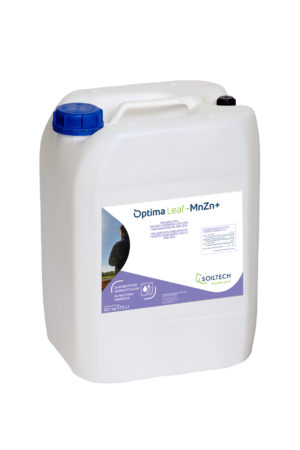In 2021, the EU decided to ban the use of the fungicide mancozeb. Because mancozeb also contains the essential nutrients manganese (Mn) and zinc (Zn), this ban will not only affect crop protection, but also has an impacts on your fertilisation strategy. As Mn and Zn play an important role in keeping crops green and therewith productive, a deficiency can lead to both yield- and quality loss.
Background
Manganese and zinc are both nutrients that are vital for essential processes in the crop, including photosynthesis. Especially on sandy soils and/or soils with a high pH the Mn and Zn availability can be poor. of This means that uptake through the roots is often not sufficient to fullfill the crops requirements. Whereas previously, applications of mancozeb automatically provided manganese and zinc to the crop, this source of fertilization is no longer possible. This will make applications of manganese and zinc as a foliar application an indispensable measure.
Each year, Soiltech conducts numerous trials to demonstrate the safety and effectiveness of its products. We recently received the results from trials that investigated the impact of the mancozeb ban, and how to compensate for its phasing out by using a manganese/zinc foliar fertiliser.
Trial setup
To avoid problems with manganese and zinc in flower bulb cultivation, Soiltech set up a trial with tulips at the research centre Vertify. All objects in the trial were given a basic fertiliser treatment via the soil. As a reference, a trial plot was used that was set up and maintained according to usual crop protection practice (including applications of mancozeb, but no foliar fertilisers). In addition, a second reference plot (without foliar fertilisers) was included in the trial. This plot was treated with an alternativ crop production strategy not containing mancozeb.
To fulfil the manganese and zinc demands, a further two plots were maintained like the mancozeb-free plot, with additional manganese (Optima Leaf-Mn+) and zinc (Optima Leaf-Zn+ ) provided by foliar fertilisers from Soiltech. The treatment on one plot alternated mancozeb (6x/year) and Optima Leaf-Mn+ and Optima Leaf-Zn+ (6x/year). The other plot was sprayed 12x with Optima Leaf-Mn+ and Optima Leaf-Zn+.
Results
The graph below reveals some interesting findings:

Firstly, a significant yield decrease of up to 4.1% was shown between the mancozeb-free object and the objects that were sprayed 12x with mancozeb. This finding emphasises once again the impact of the ban of mancozeb will have on your crop performance.
In addition, an increase weight of 8.1% was seen between the mancozeb-free spraying regime and the mancozeb-free spraying regime supplemented with Soiltech’s manganese/zinc foliar fertiliser. This demonstrates the importance of the additional manganese and zinc spray treatments since the authorisation for mancozeb is expired. The plot where mancozeb was alternated with the additional manganese and zinc treatment performed even better.
Development
The good results achieved by applying Optima Leaf-Mn+ and Optima Leaf-Zn+, encouraged Soiltech to examine the possibility of combining the two separate fertilisers into one product. This will enhance the ease of use while still achieving the same good results. This resulted in a product logically named: Optima Leaf-MnZn+.
Continuation of trials
As bulb cultivation is a two-year cycle, the bulbs harvested last year have been replanted and the same treatments will be applied in the coming growing season. We expect the differences observed in the past year to be even more pronounced in the coming year. We will also use dry matter analysis to determine how the bulbs react to the various fertilisation strategies.
In 2020, Soiltech also performed similar trials with manganese fertilisers in crops including potatoes and sugar beet. The results of these trials show a similar added value.
